
Topics
Guests
- Tim Flanneryleading Australian scientist and climate change campaigner. He was named 2007 Australian of the Year. He is author of several books, including The Weather Makers: The History and Future Impact of Climate Change.
We spend the hour with one of the world’s leading scientists studying climate change, Tim Flannery. An Australian mammologist, palaeontologist and field zoologist, he has discovered and named more than 30 new species of mammals. He has been described as being in the league of all-time great explorers such as David Livingstone. Flannery might be best known as the author of the bestselling book “The Weather Makers: The History and Future Impact of Climate Change.” Earlier this year he was named 2007 Australian of the Year. [includes rush transcript]
Transcript
AMY GOODMAN: A group of scientists in Britain are warning global warming could wipe out more than half the earth’s species in the next few centuries. That finding appears in a new study published by researchers at the University of York. Scientists examined the relationship between climate and extinction rates over the past 500 million years. They determined that rising temperatures caused three of the earth’s four biggest periods of mass extinction.
Today, we’re going to spend the hour with one of the world’s leading scientists studying climate change. His name: Tim Flannery. He’s an Australian mammologist and palaeontologist. As a field zoologist, he has discovered and named more than 60 species. He has been described as being in league with the all-time great explorers like Dr. David Livingstone. Here in this country, Tim Flannery might be best known as author of the best-selling book The Weather Makers: The History and Future Impact of Climate Change. Earlier this year, he was named the 2007 Australian of the Year. He was awarded the prize by the Australian Prime Minister John Howard. He joins us today in Santa Fe, New Mexico, for the hour.
Welcome to Democracy Now!
TIM FLANNERY: Thanks very much, Amy.
AMY GOODMAN: It’s great to have you with us, Tim Flannery. Well, we are talking today in dire times. The fires are raging in Southern California. A major drought has struck the Southeast, from Tennessee through the Carolinas, Georgia. Atlanta could run out of water. And then we’ve seen this drenching downpour in New Orleans. They had to close City Hall, close the schools. Is there a connection between the fire, the water and the drought?
TIM FLANNERY: Yeah. Look, the best way to think about these things, really, is to take a bigger global view. And Americans might feel they’re suffering from a whole lot of severe weather at the moment, but look globally and you see exactly the same thing around the world. Anywhere with a Mediterranean climate, such as Greece or Australia or California, is suffering extreme wildfires. Now, why is that happening? The climate is slowly shifting, so that the desert regions adjacent to those Mediterranean areas, you know, are starting to expand.
The same with droughts and floods. It’s not just the Southeast of the U.S. Europe has had its great droughts and water shortages. Australia is in the grip of a drought that’s almost unbelievable in its ferocity. Again, this is a global picture. We’re just getting much less usable water than we did a decade or two or three decades ago. It’s a sort of thing again that the climate models are predicting. In terms of the floods, again we see the same thing. You know, a warmer atmosphere is just a more energetic atmosphere.
So if you ask me about single flood event or a single fire event, it’s really hard to make the connection, but take the bigger picture and you can see very clearly what’s happening.
AMY GOODMAN: We were reporting just a while ago about the fires in Greece. Is there a connection to the fires in California?
TIM FLANNERY: Absolutely. It’s the same sort of environment. Greece is part of a Mediterranean climate system. And what you see there is that those very harsh conditions that characterize the Sahara to the south are now attempting to move northwards. You know, the climate is shifting, such as that those conditions are going to prevail further northwards. So, this is part of a global picture.
AMY GOODMAN: I wanted to ask you about a controversy in Washington, D.C. just this week. The Bush administration is being accused of severely editing the congressional testimony by a senior health official on the impact of climate change. The Centers for Disease Control and Prevention director, Julie Gerberding, appeared before the Senate Environment and Public Works Committee just last Tuesday. The Associated Press reports two sources familiar with both her initial draft and the White House’s revisions say the administration imposed major changes. Gerberding’s final testimony is said to have omitted lengthy passages she had initially included on the health risks of global warming. Her final document was whittled down to four pages from an initial 14.
On Wednesday, White House Press Secretary Dana Perino was asked about the controversy. This is what Dana Perino had to say.
DANA PERINO: As I understand it, in the draft there was broad characterizations about climate change science that didn’t align with the IPCC. And we have experts and scientists across this administration that can take a look at that testimony and say, “This is an error” or “This doesn’t make sense.” And so, the decision on behalf of CDC was to focus that testimony on public health benefits. There are public health benefits to climate change, as well, but both benefits and concerns that somebody like a Dr. Gerberding, who is the expert in the field, could address. And so, that’s the testimony that she provided yesterday.
REPORTER: Is it typical for the White House to cut that much of an administration official’s prepared —
DANA PERINO: You know, I don’t look at — what I can tell you, it is typical for us to review testimony that comes across. And I think that when you have an issue as large as climate change and as complicated — and the White House reaches out to all sorts of scientists across the administration when it comes to climate change — if they have concerns that the IPCC document, which we agreed to its conclusions on, does not align with the testimony, that the prudent thing to do is to move forward, to have her testimony — and remember, we only suggest the edits.
REPORTER: There’s another CDC official saying that the testimony was “eviscerated,” which is pretty — I guess, accusing the White House of playing very heavy hands.
DANA PERINO: I understand what they’re accusing us of, but I can — I just reject it. And I will tell you that, again, we believe climate change is real; we believe that humans are largely responsible; we are working on a way to solve the problem. And in the meantime, we are working with experts like Julie Gerberding to figure out what are going to be the health benefits and the health concerns of climate change, of which there are many. And she testified fully on it yesterday.
AMY GOODMAN: That was White House Press Secretary Dana Perino on Tuesday. Tim Flannery, your response?
TIM FLANNERY: Well, I guess, overall, it’s just deeply disappointing, and more than that. I mean, Dr. Gerberding is one of the world’s leading authorities in this area, and anyone would be privileged to have her input into this debate. It’s a critical issue for government. They need to know what these health issues are going to be in future, and they need a proper assessment of what the health issues are now. From what I understood of Perino’s comments on it, the White House has decided to sort of edit out anything that’s bad and keep in the good news. And that’s just not acceptable. I mean, the public of America need to know these things.
AMY GOODMAN: Isn’t there a new study on the health effects of global warming?
TIM FLANNERY: There is, indeed. And the Intergovernmental Panel on Climate Change, which is headed by an Australian who I work with and know very well —
AMY GOODMAN: The IPCC that just won, with Al Gore, the Nobel Peace Prize.
TIM FLANNERY: Absolutely, and what a great moment that was, really, for the scientific community.
AMY GOODMAN: Who is the head of it?
TIM FLANNERY: It’s a man called Dr. Tony McMichael.
AMY GOODMAN: And what does he do?
TIM FLANNERY: He’s an epidemiologist. He studies diseases, how they spread and what they — how epidemics are caused, and so forth. But their article, which was published in a very prestigious journal, establishes that there’s already an additional 70,000 deaths a year, at least, globally from the current warming that was experienced as of 2005.
AMY GOODMAN: Deaths, how?
TIM FLANNERY: This is all sorts of impacts, some from floods, some from additional malaria and so forth, waterborne diseases, a whole series of impacts already on people. And, of course, a lot of these deaths now are happening in the developing world, where people are just less capable of dealing with this sort of a — the assault, really, that this shifting climate is bringing.
But as these impacts deepen and get more severe, they’ll be felt globally. And it’s just very, very important that governments worldwide are well prepared to deal with this oncoming problem. We can’t stop a lot of the global warming that’s built into the system now. There’s a certain amount of change that’s inevitable. And it’s extremely important that people understand that and understand what the impacts of that really mean on their lives.
AMY GOODMAN: We’re talking to Tim Flannery. When we come back from break, I want to ask you about the IPCC. I mean, people in the United States certainly know Al Gore’s name, but this other group that won the Nobel Peace Prize is less well known. We’re talking to a man who many have described as one of the leading explorers in the world today, leading climate change scientists, has discovered more than 60 species. And we’ll talk about that, as well, and we’ll talk about positive solutions that people are involved with around the world. Is global climate warming going to doom us, or is there a chance to pull out of it, to counter it, to change the course that we are headed on? This is Democracy Now!, democracynow.org, The War and Peace Report. We’ll be back in a minute.
[break]
AMY GOODMAN: Our guest today is Tim Flannery. He is known around the world as one of the leading climate change experts, leading scientists, has discovered more than 60 species, was named 2007 Australian of the Year. We live in a globalized world, yet we are so insulated when it comes to getting information in this country. His name may not be as well known here, just like the International Panel on Climate Change is not as well known in the United States.
Tim Flannery, let’s talk more about the IPCC and what it has done over the years. How significant is it?
TIM FLANNERY: Well, significant enough, clearly, to win a Nobel Peace Prize, which is exactly what they should have got. That group of scientists have been working together now for over 20 years, and every five years they produce a report that really is a report on the state of our planet’s atmosphere and the warming that is damaging it. And the early reports started off rather mild in tone, you know, saying there might be a problem, and we think it might be caused by people. The last report, the fourth assessment report, which is still being reduced in — I’m sorry, released in bits this year, is much more alarming. You know, the basic news is that this is a human-caused problem, it’s getting very severe, we need to do something about it.
And it’s 400-odd scientists, along with some government representatives, and so forth. One of the problems the IPCC faces is they have to do everything by consensus. It’s a bit like the old Quakers, you know, how they used to have to get everyone to agree. And you can imagine what it’s like trying to get, for example, the representative of Saudi Arabia to agree to particular wordings of things. So it’s a long and painful process, and in my view some of the leading scientists deserve the Order of Lenin, as well as the Nobel Peace Prize, because it’s a very torturous business.
AMY GOODMAN: So the IPCC wins the Nobel Peace Prize. In the United States, there is this ongoing controversy over whether climate change is really an issue at all. You have corporations, the wealthiest in the world, like ExxonMobil, that has poured millions of dollars into Washington think tanks to simply raise questions about global warming. They also have poured, well, over $100 million into Stanford University, part of a consortium of corporations that are funding their global climate change program there. What is this doing to the science, when these corporations — BP also, now “Beyond Petroleum,” before called British Petroleum, giving half a billion dollars to the University of California, Berkeley — some are calling it “BPerkeley” now.
TIM FLANNERY: Yeah, yeah. Well, look, it very much depends on what the expectations are. I would be comfortable with partnerships, for example, with BP, purely because I have a sense that that company is on the right track. It’s by no means perfect, but it’s starting to address the fundamental problems, and they’ve made that great leap from seeing themselves as an oil company to seeing themselves as an energy company. And once you do that, you can start participating in the new industrial revolution, which is going to change our lives and clean up our planet over the next 40 years.
The bigger companies, ExxonMobil, for example, there is really no signs yet that that company has realized the nature of the world it’s now operating in, and it’s still a major problem, and particularly in the past decade. When you tally the cost of the misleading campaigns, for example, you know, ExxonMobil and its partners in the Global Climate Coalition cost us a decade of action, at least, you know? Starting with the Rio Earth Summit in 1992, those companies have been frustrating progress, and as a result of that, the burden of pollution in the air causing this warming problem has grown by 20 percent. So that is a very serious issue and, I believe, a serious liability for those companies.
AMY GOODMAN: In the United States, we have a situation where the Bush administration is vacuuming the words “global warming” off of websites. You hear the whole controversy with Gerberding, changing the wording to soften the impact of findings that climate change is a major problem. Do you have the same problem in Australia?
TIM FLANNERY: Well, look, our prime minister and George Bush were the only two leaders globally who saw fit not to ratify the Kyoto Protocol. So it gives you a sense that he’s hardly a left-winger, this prime minister of ours.
AMY GOODMAN: John Howard.
TIM FLANNERY: Exactly, yeah.
AMY GOODMAN: The one who gave you Australian of the Year.
TIM FLANNERY: He did, although — could I just say — he presented it to me; the people of Australia really gave it to me. It’s —- people make submissions from the public, and then there’s a committee process, so I think it’s -—
AMY GOODMAN: Do you think he had a hard time doing it?
TIM FLANNERY: I think he probably did, but he may have felt it was necessary. Perhaps it was — he thought at that stage he could do something to shift public perception of his stance. But that hasn’t happened. We have an election on the 24th of November, and the polls are running strongly to the opposition. And I think we’ll have a new government on the 24th of November. And their first move, they’ve said, is to recall parliament and ratify the Kyoto Protocol. So then it will be the U.S. alone, if that happens.
You ask about the nature of the White House intervention in this climate change issue. For me, it’s perplexing, it’ counterproductive. And despite the orientation of our government in Australia, it’s just not possible for them to do that. What they’ve done is cut funding to critical programs dealing with development of new energy, for example, and the monitoring of the science of climate change. And astonishingly, this year, which is the International Polar Year, Australia, which claims a third of the Antarctic, is giving zero dollars to support research into the International Polar Year. It gives you a sense of how bad things are. But we don’t get this sort of lying to the public, where people deliberately twist what their experts are saying. And I find that deeply disturbing. This is a democratic country; people have a right to know.
AMY GOODMAN: And you don’t, because of the check and balance?
TIM FLANNERY: That’s right. It’s much more difficult for our government to operate that way. We have a tradition of frank and fearless advice coming from the bureaucracy to government. And although that’s compromised when government has a particular view, it’s really impossible to eradicate and to alter wordings, such as occurs here in this country. I think it’s just — it’s a legacy of — perhaps the power of the White House and the structure that scientists work within in this country may suffer this problem.
AMY GOODMAN: Can you talk about the problem of the feedback loop? What does that mean?
TIM FLANNERY: Well, earth’s climate system is set up in a way that it’s finely balanced, so it can go along for a certain period of time in one state, and then a small impact can precipitate a whole series of changes that build on each other to rapidly shift the climate into another state. And I’d say a bit like, you know, the old analogy of the flap of a butterfly’s wing in the Amazon causing a hurricane, that’s the sort of model that you’ve got to think about when you think of this climate system of ours. And a small — a relatively small input, such as human pollution into the atmosphere, can translate into a very big impact that can become impossible for us to stop. We’re not there yet, but we could get to that point in the next few decades, if action isn’t taken.
AMY GOODMAN: In your book, The Weather Makers: How Man Is Changing the Climate and What It Means for Life on Earth, you talk about the concert of the three scenarios. What are those scenarios?
TIM FLANNERY: Well, look, those scenarios really deal with those big positive feedback loops, you know. The first is the shutdown of the Gulf Stream, which, if that occurred — and, you know, the Gulf Stream runs along the U.S. East Coast and up into the North Atlantic and brings a tremendous amount of warmth to Europe. We know it has shut down in the past. If it shuts down again, Europe will face very severe conditions, cold conditions. And that heat, of course, has to go somewhere, that was normally going north and being dissipated. My guess is it’s going to go into the Gulf of Mexico and the southern Atlantic and cause more severe hurricanes and so forth. But, you know, we have to do more science on that to really justify that view.
The second scenario is the collapse of the Amazon rainforest, you know? Climate change is looking as if it has the power to destroy those forests, which are the greatest carbon sink on our planet. So if those forests start dying, the pulse of carbon released to the atmosphere will set us on an irreversible trajectory to a world that is really hostile to the way we live and who we are.
AMY GOODMAN: How would they die?
TIM FLANNERY: What we think will happen is that the plants — as carbon dioxide builds up in the atmosphere, the plants breathe less and less. This is a very simple view of it. But when plants breathe, they let moisture go back into the atmosphere. And that moisture falls again as rainfall over the Amazon. So if the plants breathe less and there’s less rain coming in, basically we’ll see very widespread drought conditions in the Amazon. And I was very concerned last year to see those very low water flows in the Amazon, because that’s exactly what we’d expect from the first change — stages of this change. And eventually there’s just not enough water for the trees to survive, so they die. And then, the computer modeling suggests that anything is going to have a hard time growing there, because conditions become so hostile. We may get some sort of semi-desert vegetation growing where there was once a rainforest. And, of course, all that carbon that’s locked into trees, because trees are made of carbon dioxide, you know, is just released into the atmosphere and sets us on an irreversible trajectory. I hope it doesn’t happen. This is a scenario. We have scientific concerns about it. But it would be an absolute disaster for life on earth if we start to see that.
AMY GOODMAN: And the third scenario?
TIM FLANNERY: The third one concerns another greenhouse gas called methane. Vast amounts are methane are locked up in what’s called clathrates, which are an icy substance that’s found at the bottom of the world’s oceans. And it’s held in that form in the ice by pressure and temperature. So in the Arctic, for example, as temperatures increase, these clathrates become unstable, and we may see a mass release of methane. Methane is 21 times more powerful than carbon dioxide as a greenhouse gas. So if we saw a mass eruption of methane into the atmosphere, again we’re set on an irreversible trajectory towards a hostile world.
We know these sort of things have happened in the past. Predicting if and when that will happen in the future is extremely difficult. But they’re the sort of things that we really have to be aware of as possibilities, and they should act as a great spur to us to reduce the burden of pollution in our atmosphere that may unleash these very severe positive feedback loops.
AMY GOODMAN: Tim Flannery, you talk about the golden toad and the Cloud Forest of Costa Rica.
TIM FLANNERY: Well, look, that animal was really, I think, the first well-documented victim of this global climate change that we’re about — or that is looming on our horizon. It was a beautiful animal found just up in the mossy forests, and the American Indians had wonderful stories about it. They didn’t see it very often, because it only came out a couple of weeks a year. And it was golden, of course, a wonderful animal. They believed if you ever found one, you would find great happiness. And they tell stories of one person who found such a toad and didn’t know what happiness was. Another one just couldn’t bear the happiness that he had found. And a bit like us humans, really, we don’t recognize the beauty and wonder of the world that we have, and we seem willing to trade it for such short-term benefits. But, anyway, that animal is the leader in this extinction cascade that’s now emerging. As you said earlier, half of the world’s species may go extinct in the next century or two. And that would just change our world, ultimately impoverish it, destabilize it. And, you know, what a legacy to leave our children! Horrifying.
AMY GOODMAN: Tim Flannery, you write in your books about how you were a global warming, climate change skeptic. What changed you?
TIM FLANNERY: Well, I had studied geology, and good old Charles Lyell, you know, the first modern geologist, really, who wrote The Principles of Modern Geology in 1850, told us that if you want to understand the rocks, look at the world around you. You know, and that’s fine for many geological processes, but for climate change it just doesn’t work, because we’ve had a long period of climate stability. And so, as a geologist, I thought, well, climate change, it might be real, but it’s going to unfold over hundreds or thousands of years.
What really changed me was the ice core record, you know, this wonderful record. Scientists now have drilled out of the Antarctic ice cap and the Greenland ice cap, where we have a year-by-year record of the state of our planet and its atmosphere going back 640,000 years. And what that record tells us, in no uncertain terms, is that our climate can shift very rapidly from one stable state to the next with very severe consequences for life on earth. And once you understand that, that simple fact, you have to be concerned about the current indications that we’re getting from the world’s climate scientists that we are approaching a threshold to dangerous climate change and the time to act is very limited.
AMY GOODMAN: What’s happening at the North and South Pole?
TIM FLANNERY: Oh, this is, for me, the most disturbing thing. You know, the ice cap at the North Pole has been there for three million years. You know, walrus, polar bears, many unique species have evolved in that wonderful environment. And, of course, it’s an absolutely essential regulator of earth’s climate. It reflects a vast amount of heat, of energy, back into space, that doesn’t then heat our planet.
What we’ve seen, starting in the 1970s, but particularly since 2005, is a rapid melting of that ice cap. And it’s possible now that as early as 2013 there will be no polar ice cap in summer, and that will change the world, if — that is, if that happens. We cannot — I just hope that that will not happen, that we’ve got a long good time frame to act. But all indications are it’s melting with unprecedented rapidity. Once that happens, you know, the North Pole turns from a cooling agent or refrigerator for our planet to a heater, because the ocean starts trapping heat energy, and then we see a restructuring, I think, of the whole of the northern hemisphere’s climate systems. Now, how severe that will be, how it will unfold, it’s very difficult to say at the moment, but it is one of the areas of grave concern for all climate scientists. In fact, when you speak to them, they find it hard to comprehend, really, what’s happening. They keep hoping that next year things will get better. It’s not, at the moment. It is the great warning sign for us that all is not well, I think.
AMY GOODMAN: The South Pole?
TIM FLANNERY: South Pole is a little bit better off. We’re seeing melting around the margins and very severe melting out on the Antarctic Peninsula. But because the South Pole is land-based and is a very high ice cap, we’re not yet seeing those profound impacts. And I just have my fingers crossed that we’ll see ongoing stability there, because if we start seeing a severe meltdown at both poles, the changes would be astronomical.
AMY GOODMAN: The NASA scientist, Jim Hansen, is speaking in Houston at the Houston Progressive Forum, where you spoke a few months ago.
TIM FLANNERY: Yes. Yes, I did.
AMY GOODMAN: He is a man, a scientist, who has been silenced, as you point out. He’s one of the winners, really, of the Nobel Peace Prize, because he’s part of the IPCC.
TIM FLANNERY: Yeah, exactly. And what a great hero! That man has done more from a more difficult position than almost any other climate scientist. And he heads an institute, NASA, run by the federal government, and yet he’s had the bravery to speak out and try to be heard. And, you know, it was extraordinary what happened to him. They put a sort of a media manager in place who had lied about his credentials. Just an amazing incompetence.
AMY GOODMAN: Lied about graduating from college.
TIM FLANNERY: Indeed.
AMY GOODMAN: I think it was in 2003.
TIM FLANNERY: That’s right.
AMY GOODMAN: So already he was, to say the least, rather young, less than half the age of Jim Hansen.
TIM FLANNERY: Can you imagine what it would be like for one of the world’s leading scientists, who is revered by everyone, to have this pipsqueak who lied about his credentials controlling what he tells the public? Just appalling. And, you know, the countries around the world would — I don’t know what they’d pay to have the advice of a Jim Hansen. It’s the sort of stuff we all desperately need. And here, in a country that actually pays him a salary and allows him to do his work, he is silenced. I mean, I honestly cannot see the sense of that. I can’t see who benefits.
AMY GOODMAN: We’re going to break again, but we’re going to come back to Tim Flannery and ask him what it is like to discover a species. Also, I want to talk about the wars of the 21st century and how they’ll differ from the wars of the 20th century. This is Democracy Now!, democracynow.org, The War and Peace Report. We’ll be back with one of the world’s leading climate change scientists in a minute.
[break]
AMY GOODMAN: We’re broadcasting from Santa Fe, New Mexico, where last night hundreds of people crowded into the historic Lensic Theater for an evening sponsored by the Lannan Foundation, a speech by Tim Flannery — Tim Fridtjof Flannery, to be exact. Fridtjof, named for, well, a distant relative, a Norwegian explorer, Fridtjof Nansen, who was an explorer, a diplomat, won the 1922 Nobel Peace Prize. A relative of yours, Tim Flannery.
TIM FLANNERY: Yeah, supposedly. We haven’t been able to trace back how, but apparently he is, yeah.
AMY GOODMAN: A chip off the old block. What is it like to discover a species? Talk about one of the most remarkable ones that you did discover.
TIM FLANNERY: Well, it’s a very humbling experience. And if I could just say that I’m more like the person who presents the species to the world, because often the local people where I work, the indigenous people, have known about these animals for some time. But one of the most extraordinary discoveries, really, was of a tree kangaroo. Now, I know people don’t think about kangaroos hopping around in the treetops of the tropical rainforest, but they do. There are seventeen species of them. And in 1995, I discovered one species of tree kangaroo that had come down from the treetops and lived in the alpine meadows under the glaciers of the highest mountains in our region, in West Papua. And that animal was about the size of a Labrador dog and looked like a little panda, black and white, gorgeous animal. And it was really tame. It didn’t have any fear of people, because there was no people in its habitat. That was an amazingly humbling moment to think that, you know, I’m the first outsider to see this creature. It was just fantastic.
AMY GOODMAN: As you talk about indigenous people, the indigenous people you work with, in your book, Throwim Way Leg: Adventures in the Jungles of New Guinea , what does ”throwim way leg” mean?
TIM FLANNERY: It means “Hit the road.” I mean, Papua New Guineans walk everywhere, because there is no roads through most of the country. So when they’re going, you know, after a meeting, they say, ”Me by throwim way leg now.” It means, “I’m going to hit the road” or “See you later.”
AMY GOODMAN: Well, you dedicate the book to Jim Bob Moffett, his successors and all the other CEOs of mining companies with interests in Melanesia in the hope that, through reading it, they’ll understand a little better the people whose lives they’ve so profoundly changed. Explain Jim Bob Moffett’s company, Freeport-McMoRan.
TIM FLANNERY: Well, Freeport-McMoRan runs the world’s largest copper mine in West Papua.
AMY GOODMAN: It’s based here in the United States.
TIM FLANNERY: It is based in New Orleans. And the mine itself, though, is in West Papua, and it’s in a very remote region that has dense populations of people who are really still living pretty much a Stone Age existence. And, of course, that mine just has had enormous impact. One of the most profound impacts is that the agreement to operate in that area was forged under the Suharto government, and it involved a fairly significant military presence.
AMY GOODMAN: The dictator of Indonesia.
TIM FLANNERY: That’s right, yeah, yeah, yeah. So the mine has acted as a focal point for those — for military officers to come in and then really suppress those local people. Indonesia sees West Papua as its sort of wild frontier, and the sort of things that happened here on the frontier in the 1850s are now going on in West Papua: displacement and murders of indigenous people, the theft of resources, really an attempt, you know, to take that wealth for others. Now, things have got better, very much better under the recent president, but there are still significant abuses going on in that area perpetrated by the military.
AMY GOODMAN: One of the controversial proposals you’ve put forward is using models of indigenous people in Australia, how they dealt with the environment today. You’re a fierce critic of coal mining.
TIM FLANNERY: Yes. Yeah, I am. I think coal brings many problems with it. It’s not just the global warming, although that’s probably the most significant. You know, the reason that we can’t eat fish or pregnant women shouldn’t eat fish too often is that the mercury that’s got into the fish, the food chain of fish in the oceans, most of that mercury comes from burning coal, people don’t realize. Cadmium poisoning from burning coal. The sulfur problems we’ve got from burning coal.
AMY GOODMAN: Mercury in the fish from burning coal?
TIM FLANNERY: Yeah, that’s where it comes from. Mercury gets up in this wonderful atmosphere of ours and is dispersed across the planet within a few weeks. And some of that mercury falls to the oceans, where it is oxidated and then it tends to preferentially build up in living things. So by the time we eat tuna, it’s full of the mercury that has come from the smokestacks of our coal-fired power plants.
AMY GOODMAN: Talk about geothermia and the hot rocks.
TIM FLANNERY: Well, look, it is so important that we get this new industrial revolution happening and move from the dirty fossil fuels to clean sources of energy. One of the most promising is geothermal energy. You know, it’s an old source, really. We’ve had some geothermal plants around the world for a long time. But recently there’s been astonishing discoveries of massive reserves of heat energy in the earth’s crust. One of the biggest is in Australia. And I’ve proposed to our government that we try to exploit this clean and sustainable energy resource to run a lot of our heavy industrial needs, such as mineral processing. We could have a new city in central Australia that I’ve sort of called Geothermia, you know, based around the use of this resource, and use our national rail system to bring in minerals to be cleanly processed and then shipped out.
AMY GOODMAN: Now, explain how this was discovered, where it is in the earth.
TIM FLANNERY: Look, it’s in the most dismal spot in Australia. It’s right in the dead center of our continent, near Lake Eyre, which is a huge salt pan, and it’s four kilometers down in the earth. And it was discovered by an oil and gas company, who had discovered a ring of oil-bearing rocks and then a ring of gas-bearing rocks and, in the middle of this, really hot rocks.
They spent hundreds of millions of dollars drilling. And being an oil and gas company, they thought, “We like the oil, we like the gas, but these hot rocks, we can just post that information publicly.” And, of course, someone else came up and said, well, the amount of energy in the hot rocks is actually probably a hundred times greater than the energy in the oil and gas they discovered, so this is the real gem. And so, they got a free ride. They got a couple hundred million dollars’ worth of free drilling, and now they’re going out trying to exploit this resource.
And we’ll know by Christmas, I think, whether this can be successfully done. The second drill bit is now deep in the earth. It’s getting close to those hot rocks. And if we can get circulation happening of the hot fluids, as projected, then we will have unlocked an enormous energy resource at about the price of coal. And that will change everything for Australia.
AMY GOODMAN: And how long would it last?
TIM FLANNERY: If you run the whole Australian economy on it, it will last at least a century. And that’s the one deposit, you know. This is — there’s 10 companies looking for more of these hot rocks in Australia now. And in China there’s great prospects, as well. There’s prospects in Europe and, doubtless, in parts of the U.S. So as we shift away from coal and take a medium to long-term view, we can’t just imagine the choices between clean coal technologies and nuclear power. There are other very formidable sources of power that can deliver large volumes of what’s called baseload electricity, you know, the stuff you need 24 hours a day, at low cost.
AMY GOODMAN: Let’s talk about your proposals around a green electrical grid, green transportation.
TIM FLANNERY: Yeah, look, we know that in order to beat this problem we have to reduce our emissions on the order of 80 percent in the next 40 years. Now, 40 years might sound like it’s a long way off, but it isn’t really, you know. I suppose just to drive home to people what that means, it means that in 40 years from now we can’t be driving cars that are fueled with fossil fuels, with oil. We can’t be generating our electricity by burning coal and natural gas. We have to have shifted decisively from those polluting sources of power to clean sources of power. So that’s why the race is on now for new affordable takes to harness energy of the sun, which is massive, to harness wind energy, wave energy, geothermal energy, all of these sources that will drive this new clean and prosperous economy of ours, if we can reach out, make the investments and push forward to avoid dangerous climate change.
AMY GOODMAN: Tim Flannery, can you talk about air conditioning?
TIM FLANNERY: Well, air conditioning is a very strange thing. Of course, as our earth warms, it’s becoming more and more necessary for older people and especially young people who are vulnerable to heat waves and so forth. But it also, at the moment, relies on the burning of fossil fuel. And, of course, it is the great driver of demand. So industry is rubbing its hands together at the moment and saying, well, let’s build a few more coal-powered power plants so we can supply the demand. And, of course, that’s just worsening the problem of the warming. So it’s a very vicious feedback loop. The more we air condition, if we do it using traditional energy sources, the worse the problem gets. You know, so it’s a zero-sum game. And we have to break out of that sort of thinking and see the whole picture, see the bigger picture, and start working really as a species to try to regulate the burden of gases in our atmosphere for the good of all. And that’s going to be the great enterprise of this century of ours, this 21st century, it’s taking that bigger view.
AMY GOODMAN: When you talk about wind and solar, you’re not talking just about a technical solution. This is a serious challenge to large consolidated corporations, because inherent in them is a more decentralized approach, a cooperative approach. Can you explain that?
TIM FLANNERY: Well, that’s absolutely right. I mean, electricity is a generic product, and I can generate some now by rubbing my backside on this seat, you know, static electricity. We can all do it. And once you realize that, and you can think, “Oh, I’ll put some solar panels on my house,” you’re getting rid of your power bill. And that means that the company is not getting those payments that they love every three months. Into the future, we can take control of our own future. Micro wind turbines are now being produced, which are —
AMY GOODMAN: Micro wind turbines.
TIM FLANNERY: Yeah, very, very cost-effective, and in windy areas such as this in New Mexico, a fabulous way of generating electricity. I mean, could I just say, we’re sitting in New Mexico, which has more sunlight per day than you would want to think about, more energy per square meter than we could ever possibly use, wonderful wind resource. And all of that’s just going to waste at the moment. People are just paying for fossil fuels brought in from elsewhere to run their energy needs, which is crazy.
AMY GOODMAN: You write about minicats. What are they?
TIM FLANNERY: They’re a new innovation in motor vehicles. Now, we don’t know yet whether they’re going to work out or not, but they’re compressed-air cars.
AMY GOODMAN: Compressed-air car?
TIM FLANNERY: Yeah, yeah. You compress air into sort of containers that we now use for natural gas and then run your car off compressed air. Now, they’re potentially very good for city transport. And if we use a hybrid system, hybrid electric/compressed-air system, we can get greater synergies. But these are the sorts of things that people are going to be driving 40 years from now. We can’t be driving Humvees anymore, or Hummers, I think, as you call them here, 40 years from now, or anything like them. We have to be — for transport energy, we have to be driving cars that are at least 10 times as efficient in their use of energy as the ones we use today, and they can’t be using fossil fuels. So whoever cracks that, you know, they’re going to be the wealthy of the future.
And can I just say, it’s been so disappointing to see the American car industry lobby relentlessly against its own best interest. You know, if you look at what’s happened in California, where the government has regulated outboard motors to the point where America now makes the best and cleanest outboard motors in the world. They’re the equivalent of the Toyota Prius, and they will cream the opposition globally for marine transport. But the car industry have been big enough to stand up to California and argue their tops about regulation. And as a result, they’re going down the plughole; they’re going down the gurgler. And, you know, it’s so sad to see American industry argue so thoroughly and efficiently against its own long-term interest. I really don’t understand why that’s happening.
AMY GOODMAN: Tim Flannery, here in New Mexico yesterday, you went to a high school in Santa Fe, and you were talking to the kids about what they can do. Can you tell us about the proposals you made to them?
TIM FLANNERY: Well, what I said to them was, “At the moment, kids, you’re living like cattle in a feedlot. The electricity comes down the lines to you, and you never think about where it comes from or what the consequences of the use are. Same with your water. You never think where it comes from or where it goes to. And your food. So the first step of creating a more sustainable life is to get out of that feedlot. Ask your mom and dad for the power bill, to see it, you know? And have a look at that power bill and try to understand its consequences and what it means. And give mom and dad a challenge. Say, you know, 'Look, if I can save a hundred bucks a quarter off that power bill, will you give me 200 for pocket money?' That’s a fair deal, I reckon, you know?”
AMY GOODMAN: So you save money on the energy bill, and the kids pocket what they save.
TIM FLANNERY: Yeah, pocket it and empty it, you know. Yeah, which is great incentive, because kids understand this stuff, and it’s a great thing for them to think we’ll turn things off at standby. And what a learning experience to learn how much electricity it takes to run a refrigerator, a television, a computer, and how you can save energy by turning them off at standby. Or buy some new light globes and start big savings immediately. So, you know, we’ve got to just —
AMY GOODMAN: Incandescent bulbs allowed in Australia?
TIM FLANNERY: They won’t be after 2009. You know, they were invented by Thomas Edison a century ago. And it always astonishes me that in cartoons in the U.S., you see the guy having a bright idea with the light bulb. It’s actually the dumbest idea around, that light globe, you know? We need the compact fluoro to appear in the thought bubble, because that’s the future.
AMY GOODMAN: How did it happen that Australia is completely banning them?
TIM FLANNERY: Well, our environment minister is an ingenious man. He works for a very right-wing government, but he himself ran Goldman Sachs for some time. Very smart, understands the issues. And he saw this as a win-win for everyone. And it’s amazing, because the industries even that sell lights in Australia have got on board with this. It’s been wonderful to see the transformation. So in our country, we will move to the new clean technologies within the next couple of years. And I think it’s something the whole world could do so easily.
AMY GOODMAN: The meeting that will be taking place in Bali in December, how important is this? Who’s meeting? And what role is the U.S. going to play in that?
TIM FLANNERY: Well, this is the Kyoto process, you know, and the U.N. process. The nations of the world are going to get together there to start trying to broker some aspects of the new treaty that will replace Kyoto. There will probably be an emphasis on tropical forests there, just because Indonesia is such an important repository of those forests. But we will build between then and December 2009 in Copenhagen the foundation stones of the new treaty.
And have a guess what two countries don’t have a seat at the table: your country and my country, which is the great tragedy. You know, Kyoto now is coming to the end. But the signatories, the people who’ve ratified, are sitting around building the future, and we’re locked out, which is why it’s so critically important that we ratify and get a seat and get heard. Of course, the world would love to have us join in this. And China has recently said, you know, that if the world can agree on an approach, they’ll come on board, whatever that approach is. So the ball is in our court now. Australia and the U.S. really need to make some very serious decisions in the next two years about how we address this problem. And, of course, this being a global problem — the atmosphere is a global commons — we need everyone to join in. We can’t do it on a country-by-country basis. We have to have a common meeting point.
AMY GOODMAN: You have painted such a dismal scenario of what can happen with global climate change, global warming. And yet, you remain hopeful; why?
TIM FLANNERY: Because the solutions are actually within our grasp, you know? When you see the changes that humanity has performed in the past, you know, whether it was World War II, where we went from having a sort of very primitive sort of technology to having rocketry and nuclear weapons, which are not a great thing, but they’re an amazing technical triumph, you know, radar and so forth, we know we can take these technologies that are now in nascent form and scale them up and produce a cleaner and greener world.
And the other thing, if I could say to you, is that I’m confident because I can see that this is going to be the great project of the 21st century. This is what will enthuse people. This is what will make people wealthy. It’s a bit like in the 19nth century, you know, the emphasis was on slavery and universal suffrage, and all of those things that we benefit from so much today, those changes. The 21st century is going to be about sustainability. It will be the great energizing project, and none of us can afford to be left behind.
AMY GOODMAN: Tim Flannery, I want to thank you very much for being with us. Tim Flannery, here with us in Santa Fe, New Mexico, Australian of the Year for 2007, zoologist, palaeontologist, one of the world’s leading climate change scientists.

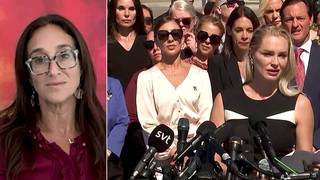
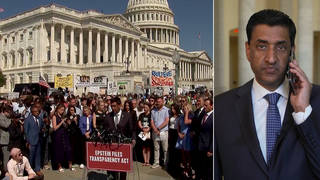
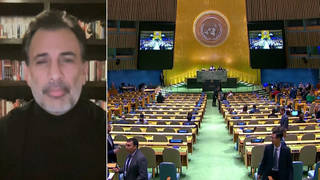
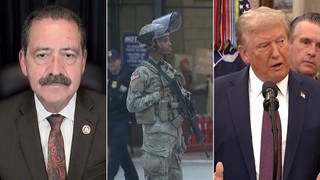
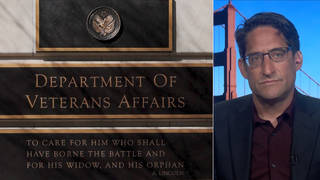
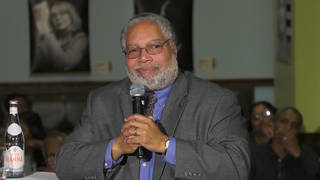

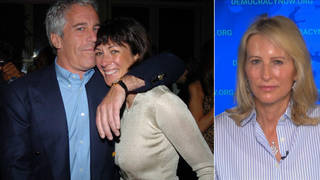

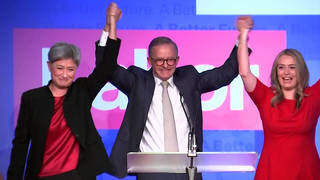
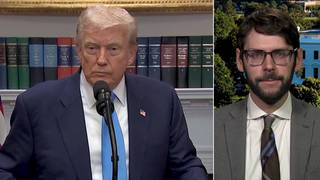
Media Options